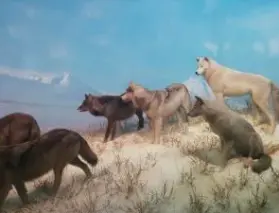 What is real? It is common sense to distinguish the real from the imaginary – real tigers can maul us, imaginary tigers cannot. For humans of all time and place, differentiating the real from the imaginary has been important for survival. Our notion of progress includes the idea of our becoming better at distinguishing the real from the unreal. Modern science is valued as the method that helps us do this.
What is real? It is common sense to distinguish the real from the imaginary – real tigers can maul us, imaginary tigers cannot. For humans of all time and place, differentiating the real from the imaginary has been important for survival. Our notion of progress includes the idea of our becoming better at distinguishing the real from the unreal. Modern science is valued as the method that helps us do this.
Looked at in this way, the mythologies of earlier ages seem a failure of progress. They present an imaginative, but unreal vision of the world. As such, they would appear to have nothing of value to offer us modern humans. Mythology, fairy tales, daydreams and other forms of imagination would seem to be something for children that is best abandoned as we become adults. But, is the imaginary really to be so lowly valued?
When we imagine something, we are picturing something that does not actually exist. In some cases such imagining is mere delusion. Yet, in giving us the ability to see what is not there, imagination can also be inspiration. As an example, long ago, a person looked out on the Saharan Desert in Egypt and imagined a pyramid where in reality there was only blowing sand. This act of imagination was the seed that ultimately led to a pyramid really existing in the desert, a pyramid which is still a part of our reality.
This story can be repeated across the globe and the ages, and it can be repeated for countless other items that make up our modern reality. Works of art, buildings, aqueducts, roadways, and machines all begin in acts of imagination. The human imagination, for better or worse, has transformed the reality of the earth’s surface. This is hardly child’s play. The ability to distinguish what actually exists from the imaginary might be part of the human genius, but the ability to see what doesn’t exist (yet) and make it part of reality is the other, probably greater, part of that genius.
This transformation, of course, involves a great deal more than the faculty of imagination. It involves many forms of technical know-how, the ability to plan and set goals, the ability to organize a work force, the will to see things through to the end, and other such talents. But in such acts of creation, all of these other human faculties are brought together in the service of transforming the imaginary into the real.
The imagination of a pyramid did not simply come out of the blue. The most impressive creations from earlier times were inspired by mythology – I mentioned the pyramids, but such awe inspiring works as Angkor Wat, the Parthenon, and Chartres were also inspired by mythology. Even the Empire State Building, was partly inspired by the mythologies of Progress and America’s destiny. Mythology is perhaps the deepest and most mysterious form of human imagination.
Inspiring great monuments is part of the story of the imagination, but long before the human imagination began its radical transformation of the earth’s surface, it had began a different type of transformation that was probably even more important to human survival. It helped transform the human soul.
* * *
One of the earliest forms of human technology is the making of clothes. Clothing allowed humans to move from warm climates to colder ones. But in nearly all the peoples that modern anthropologists have studied, clothing serves a function beyond temperature control. It is also a means of expression. Clothing expresses gender, status, role and other such attributes. Often this expression is done through imaginative design and decoration. Greater adornment in the clothing usually indicates higher status in the person.
As we adorn our bodies with clothing, so also we adorn our naked motivations with cultural forms – customs, rituals and rites. By “naked motivations” I mean our biological instincts. Like all other animals we need to eat and are motivated to reproduce. As social animals we seek status within a larger group. Our basic behavior is motivated by these biological imperatives. But we behave quite differently than most other animals in relation to our instincts.
We need to eat and drink, but we have customs about what food is proper to eat and at what times. We are motivated to reproduce, but we have elaborate courtship rituals that channel our sexuality into sanctioned forms of expression. No less than wolves or apes we seek to improve our status within our social group, but again we have elaborated forms for the correct and incorrect way to seek and exhibit status. The evolution of such cultural forms is an imaginative activity that is often related to a culture’s central myths.
Just as different cultures have different styles of dress, so they have different cultural forms in which they clothe their biological motivations. We in the modern West have increasingly less agreement on such forms. As moderns we have rebelled against the restrictiveness of traditional forms as we rebelled against traditional clothing. But that we still abide by such “appropriate” forms can be seen by the strong reaction that we still have when people behave “inappropriately,” particularly in regards to approved and unapproved sexual conduct.
* * *
Earlier I noted that real tigers can harm us, but imaginary ones can’t. Yet, imaginary tigers can inspire us. Humans have often used imaginary animals as symbols and embodiments of various virtues and vices. While one aspect of cultural forms is to channel and restrict our naked impulses (our vices), another aspect is to create ideals (virtues). In the creation of ideals of human behavior, mythology has played a progressive role in our cultural evolution.
Just as a person can look out on the world and imagine something that does not yet exist and then bring it into existence, so a person can also look inward at his or her own self and behavior, imagine it being better, and actualize this improvement. In the imaginative language of spiritual alchemy, a person can transform his or her leaden biological being into the gold of a more spiritual being.
* * *
To sum up, the imagination has many values. It has helped inspire humanity’s most impressive creative acts, has been integral in the development of the everyday customs that help us get along with one another, and it has served to inspire us to become better, more virtuous, beings. Certainly, not child play.*
In an endeavor such as building a cathedral or of putting a person on the moon, the activity begins with an act of imagination and vision: seeing what does not yet exist. It is carried forward by the power of will (intentionality), will that is undaunted by the immense effort and many setbacks that are always encountered in such undertakings. Will harnesses the power of emotions to carry it forward. Reason provides the strategies and solves the problems encountered along the way. Each of these faculties has its role in such endeavors. Similarly, if we seek to improve ourselves, a creative act requiring all our faculties is involved.
Distinguishing between the real and creatively imagining and transforming the real are both parts of the human genius. Broadly speaking, these are the realms of the sciences and the various arts, realms that have become rather divorced from one another. Some Spiritual Naturalists put a particularly strong emphasis on the sciences, but in my vision of Spiritual Naturalism, these two realms are brought together and have an equal status. Together they help us develop a rational judgement on and a creative response to that which we meet in our life.
* In particular, the psychologist James Hillman has written eloquently about the value of the imagination and its importance in developing a soulful response to life.
Learn about Membership in the Spiritual Naturalist Society
__________
The Spiritual Naturalist Society works to spread awareness of spiritual naturalism as a way of life, develop its thought and practice, and help bring together like-minded practitioners in fellowship.













